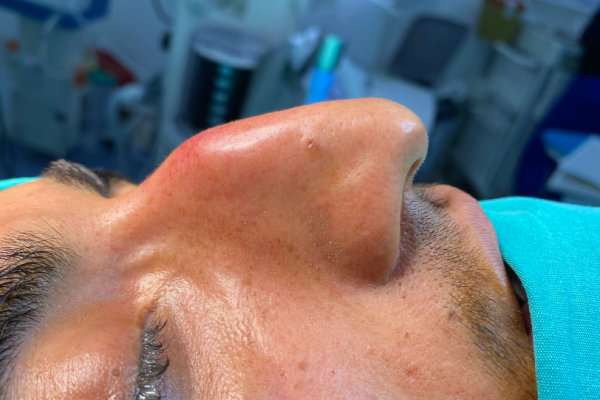Differences Between Rhinoplasty and Septoplasty
Rhinoplasty and septoplasty are two different surgical procedures related to the nose, and both are commonly performed to address either aesthetic or functional issues. However, these two procedures differ significantly in terms of purpose, techniques, and outcomes. Here is a detailed guide to understanding the differences between rhinoplasty and septoplasty:
What is Rhinoplasty?
1. A Surgery for Aesthetic Purposes
Rhinoplasty is usually a surgical procedure performed to alter the aesthetic appearance of the nose. This surgery is applied to achieve aesthetic goals such as reducing the size of the nose, reshaping the nose tip, correcting the nasal hump, or adjusting the size of the nostrils.
2. The Surgical Process
Rhinoplasty is typically performed under general anesthesia, and the surgeon usually makes incisions through the nostrils to access the nasal structure. During the surgery, the nasal bones, cartilage, and soft tissues are shaped or repositioned to achieve a nose shape that meets the patient’s aesthetic expectations.
3. Results and Recovery Process
Rhinoplasty generally provides the patient with a nose structure that is more harmonious with their facial features and aesthetically pleasing. The recovery process may take several weeks, with swelling and bruising, but the final results may take a few months to become fully visible.
You can find detailed information about rhinoplasty here.
What is Septoplasty?
1. A Functional Surgery
Septoplasty is a surgical procedure usually performed by ENT (Ear, Nose, and Throat) specialists to correct deviations or abnormalities in the nasal septum (the cartilage and bone structure that divides the nasal cavity). This surgery is typically applied to resolve breathing difficulties.
2. The Surgical Process
Septoplasty is performed through incisions made inside the nose, and the surgeon corrects the septal deviation or removes any protrusions. The surgery is carried out through the nostrils, so no external scars are visible. Septoplasty is usually performed under general or local anesthesia.
3. Results and Recovery Process
Septoplasty typically improves the patient’s breathing function. The recovery process after septoplasty may be quicker compared to rhinoplasty, and patients can generally return to normal activities within a few days.
Key Differences Between Rhinoplasty and Septoplasty
1. Purpose
-
- Rhinoplasty: Performed to improve the aesthetic appearance of the nose. It aims to change the size, shape, and overall aesthetics of the nose.
-
- Septoplasty: Performed to resolve functional issues such as breathing difficulties. It aims to correct deviations in the nasal septum.
2. Surgical Technique
-
- Rhinoplasty: Involves reshaping the nasal structure by working on the nasal bones, cartilage, and soft tissues. It typically includes aesthetic changes.
-
- Septoplasty: Focuses on correcting the nasal septum. Deviations, protrusions, or abnormalities in the nasal septum are addressed.
3. Scope of Surgery
-
- Rhinoplasty: The scope of the surgery is broader and generally involves different parts of the nasal structure. Both aesthetic and functional changes can be made.
-
- Septoplasty: The surgery focuses solely on the nasal septum and usually does not make significant changes to the external appearance. Septoplasty is a more limited procedure.
4. Recovery Time
-
- Rhinoplasty: The recovery time is generally longer, with swelling and bruising lasting several weeks. The final results may take months to appear.
-
- Septoplasty: The recovery time is usually shorter. Swelling and bruising may be less compared to rhinoplasty, and patients typically recover within a few days.
5. Aesthetic Changes
-
- Rhinoplasty: Involves noticeable aesthetic changes to the nasal structure, which can create a visible difference in the patient’s facial aesthetics.
-
- Septoplasty: Does not involve significant aesthetic changes. The goal is functional improvement.
Combined Surgeries: Septorhinoplasty
1. Both Aesthetic and Functional Improvement
In some cases, rhinoplasty and septoplasty procedures can be performed together. This type of combined surgery is known as septorhinoplasty. Septorhinoplasty aims to improve both aesthetic and functional aspects, allowing the patient to breathe better while enhancing the appearance of the nose. Those considering septorhinoplasty should consult with an ENT specialist, as the surgery involves not only cosmetic changes but also the repair of the airways.
2. Advantages of Combined Surgery
Septorhinoplasty is ideal for patients who are considering nasal aesthetics but also have breathing problems. This way, both aesthetic and functional issues are resolved with a single surgery.n
Rhinoplasty and septoplasty are two different surgical procedures that target different purposes related to the nose. While rhinoplasty is performed for aesthetic reasons, septoplasty is applied to resolve breathing difficulties. Both procedures can enhance the patient’s quality of life, but the correct surgical choice depends on the patient’s needs. In some cases, combining both surgeries, known as septorhinoplasty, can provide both aesthetic and functional benefits.
Assoc. Prof. Dr. Sema Koç, as an ENT specialist, offers the best surgical options to her patients in her clinic in Antalya, with expertise in both rhinoplasty and septoplasty. If you would like to learn more about nasal aesthetics or functional nasal surgery, feel free to contact our clinic.
Get to know Assoc. Prof. Dr. Sema KOÇ closely About
Author





